Accounting and Governance Report: Galore Ltd Analysis, ACCG101, 2019
VerifiedAdded on 2022/09/28
|6
|1138
|34
Report
AI Summary
This report analyzes the accounting and governance practices of Galore Ltd., focusing on the management of doubtful debts and its impact on the company's financial statements. The report begins by outlining the factors considered when calculating the yearly allowance for doubtful debts, emphasizing the importance of Generally Accepted Accounting Standards (GAAP) in adjusting accounts. It then examines how doubtful debts, specifically bad debt expenses and the allowance for doubtful debts, affect the income statement and balance sheet. The second part of the report discusses the managing director's preference for a sustainable 5% growth rate over an aggressive 10%, considering market saturation and economic conditions. The report concludes by highlighting the positive impact of increasing the doubtful debt rate to 4% and maintaining a stable 5% growth rate, benefiting stakeholders and ensuring long-term financial stability for Galore Ltd.
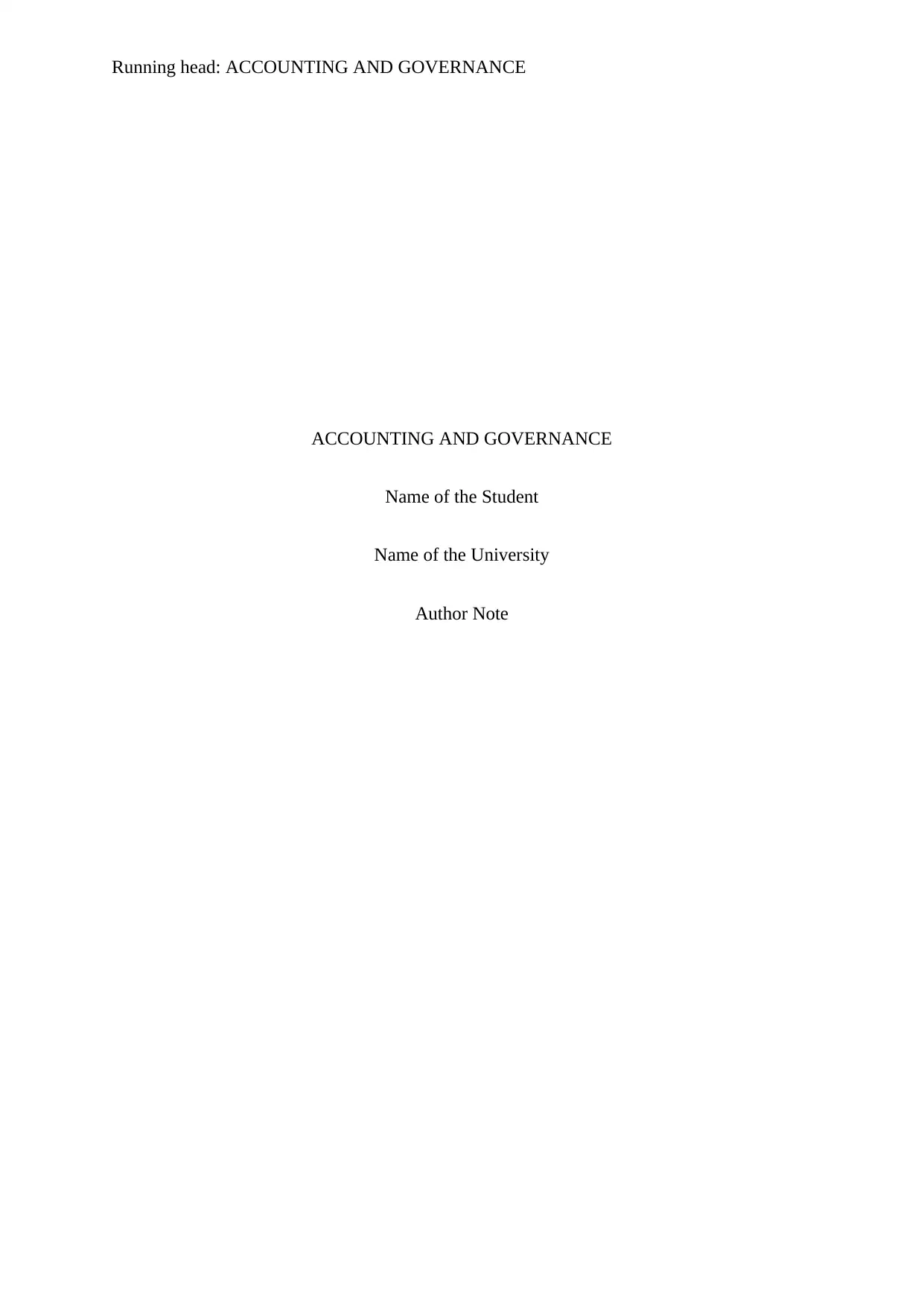
Running head: ACCOUNTING AND GOVERNANCE
ACCOUNTING AND GOVERNANCE
Name of the Student
Name of the University
Author Note
ACCOUNTING AND GOVERNANCE
Name of the Student
Name of the University
Author Note
Paraphrase This Document
Need a fresh take? Get an instant paraphrase of this document with our AI Paraphraser
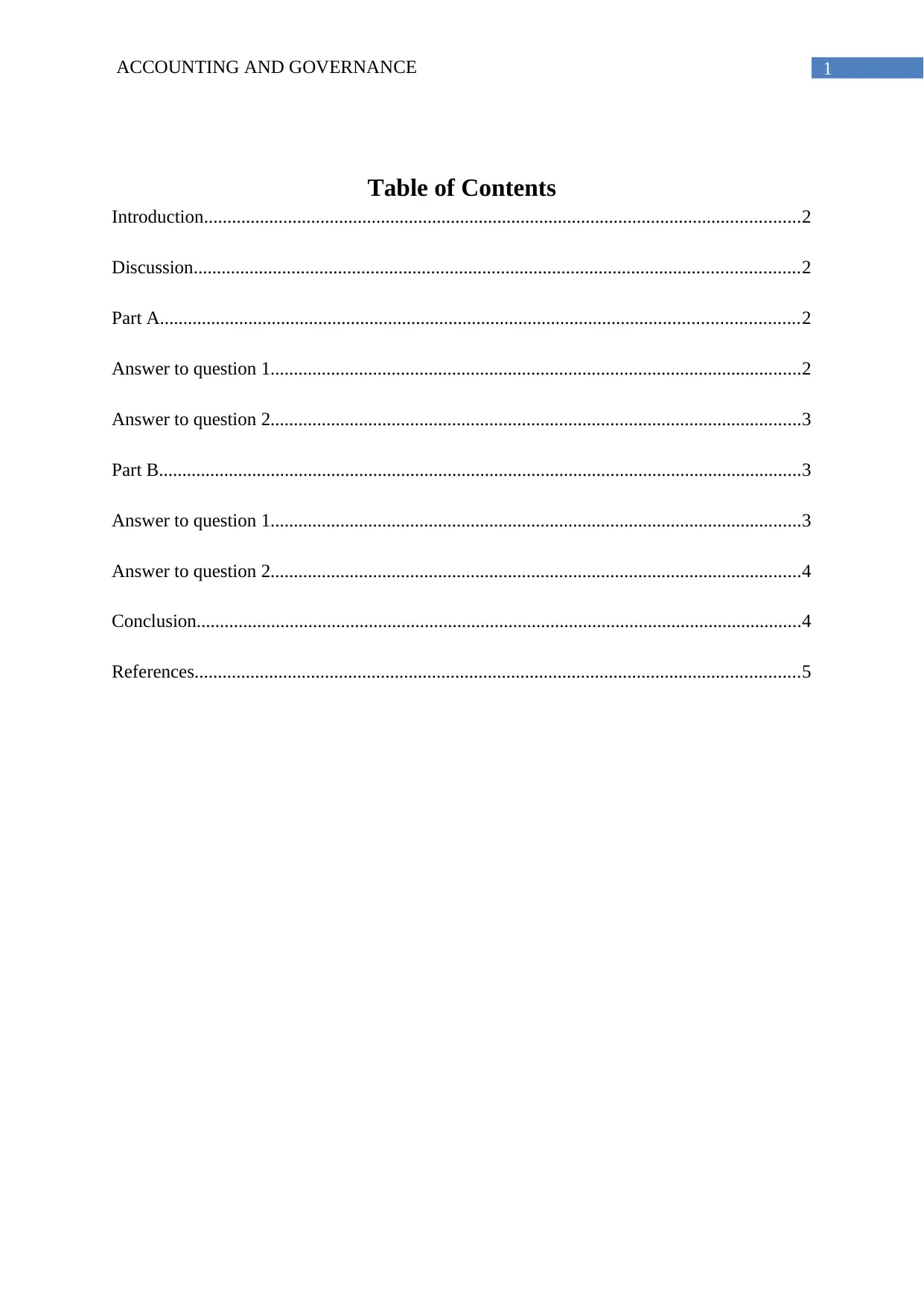
1ACCOUNTING AND GOVERNANCE
Table of Contents
Introduction................................................................................................................................2
Discussion..................................................................................................................................2
Part A.........................................................................................................................................2
Answer to question 1..................................................................................................................2
Answer to question 2..................................................................................................................3
Part B..........................................................................................................................................3
Answer to question 1..................................................................................................................3
Answer to question 2..................................................................................................................4
Conclusion..................................................................................................................................4
References..................................................................................................................................5
Table of Contents
Introduction................................................................................................................................2
Discussion..................................................................................................................................2
Part A.........................................................................................................................................2
Answer to question 1..................................................................................................................2
Answer to question 2..................................................................................................................3
Part B..........................................................................................................................................3
Answer to question 1..................................................................................................................3
Answer to question 2..................................................................................................................4
Conclusion..................................................................................................................................4
References..................................................................................................................................5
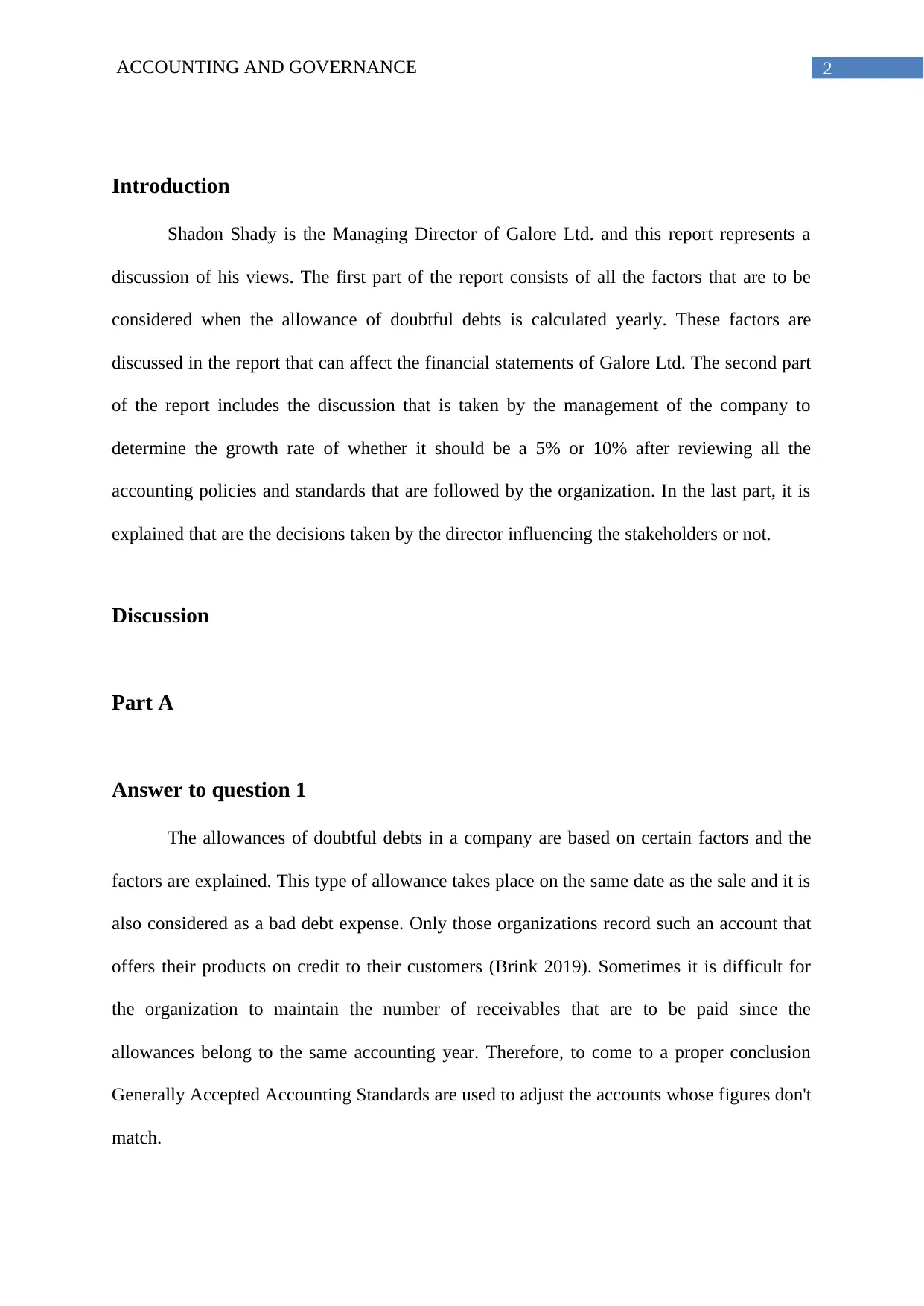
2ACCOUNTING AND GOVERNANCE
Introduction
Shadon Shady is the Managing Director of Galore Ltd. and this report represents a
discussion of his views. The first part of the report consists of all the factors that are to be
considered when the allowance of doubtful debts is calculated yearly. These factors are
discussed in the report that can affect the financial statements of Galore Ltd. The second part
of the report includes the discussion that is taken by the management of the company to
determine the growth rate of whether it should be a 5% or 10% after reviewing all the
accounting policies and standards that are followed by the organization. In the last part, it is
explained that are the decisions taken by the director influencing the stakeholders or not.
Discussion
Part A
Answer to question 1
The allowances of doubtful debts in a company are based on certain factors and the
factors are explained. This type of allowance takes place on the same date as the sale and it is
also considered as a bad debt expense. Only those organizations record such an account that
offers their products on credit to their customers (Brink 2019). Sometimes it is difficult for
the organization to maintain the number of receivables that are to be paid since the
allowances belong to the same accounting year. Therefore, to come to a proper conclusion
Generally Accepted Accounting Standards are used to adjust the accounts whose figures don't
match.
Introduction
Shadon Shady is the Managing Director of Galore Ltd. and this report represents a
discussion of his views. The first part of the report consists of all the factors that are to be
considered when the allowance of doubtful debts is calculated yearly. These factors are
discussed in the report that can affect the financial statements of Galore Ltd. The second part
of the report includes the discussion that is taken by the management of the company to
determine the growth rate of whether it should be a 5% or 10% after reviewing all the
accounting policies and standards that are followed by the organization. In the last part, it is
explained that are the decisions taken by the director influencing the stakeholders or not.
Discussion
Part A
Answer to question 1
The allowances of doubtful debts in a company are based on certain factors and the
factors are explained. This type of allowance takes place on the same date as the sale and it is
also considered as a bad debt expense. Only those organizations record such an account that
offers their products on credit to their customers (Brink 2019). Sometimes it is difficult for
the organization to maintain the number of receivables that are to be paid since the
allowances belong to the same accounting year. Therefore, to come to a proper conclusion
Generally Accepted Accounting Standards are used to adjust the accounts whose figures don't
match.
⊘ This is a preview!⊘
Do you want full access?
Subscribe today to unlock all pages.

Trusted by 1+ million students worldwide
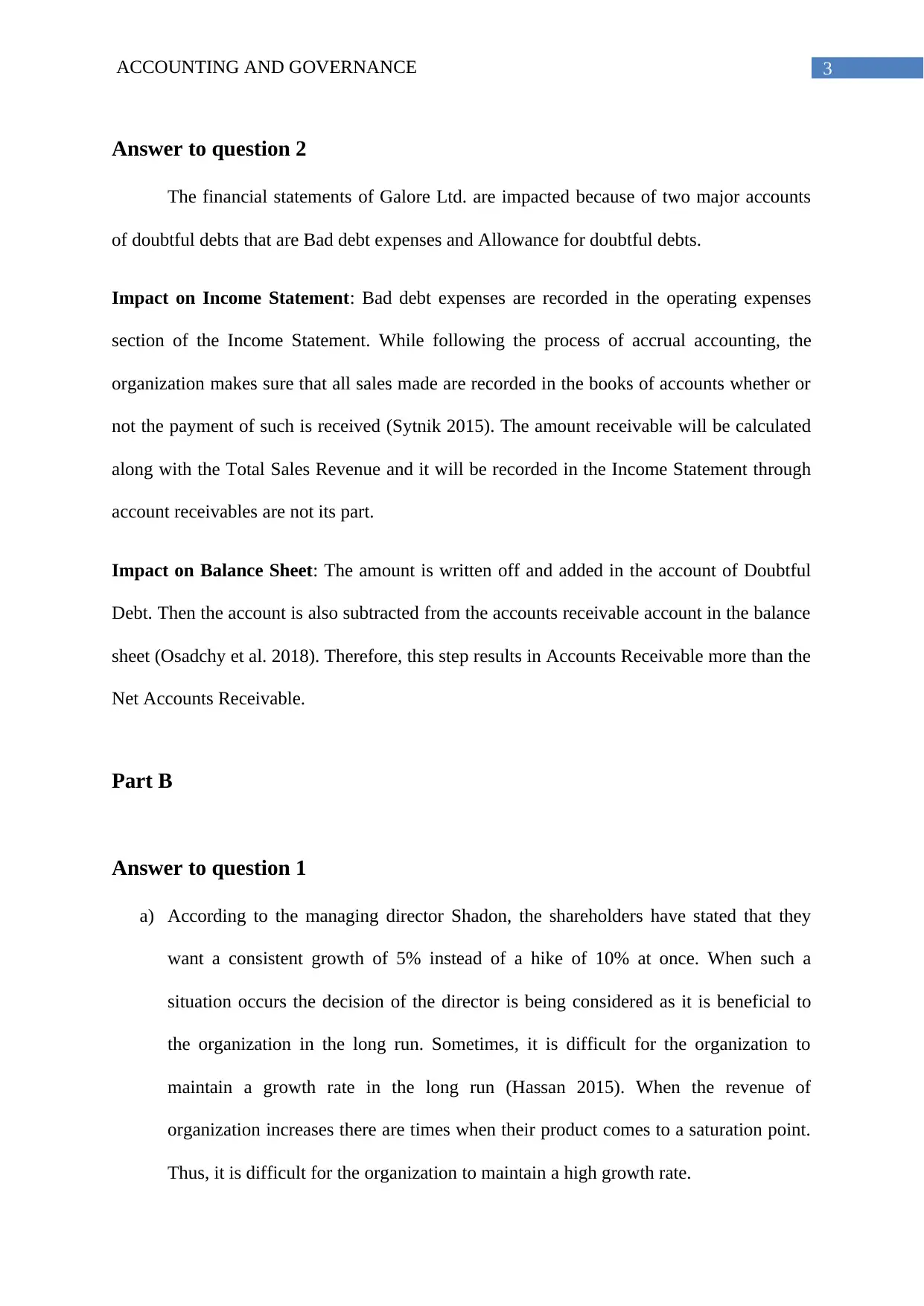
3ACCOUNTING AND GOVERNANCE
Answer to question 2
The financial statements of Galore Ltd. are impacted because of two major accounts
of doubtful debts that are Bad debt expenses and Allowance for doubtful debts.
Impact on Income Statement: Bad debt expenses are recorded in the operating expenses
section of the Income Statement. While following the process of accrual accounting, the
organization makes sure that all sales made are recorded in the books of accounts whether or
not the payment of such is received (Sytnik 2015). The amount receivable will be calculated
along with the Total Sales Revenue and it will be recorded in the Income Statement through
account receivables are not its part.
Impact on Balance Sheet: The amount is written off and added in the account of Doubtful
Debt. Then the account is also subtracted from the accounts receivable account in the balance
sheet (Osadchy et al. 2018). Therefore, this step results in Accounts Receivable more than the
Net Accounts Receivable.
Part B
Answer to question 1
a) According to the managing director Shadon, the shareholders have stated that they
want a consistent growth of 5% instead of a hike of 10% at once. When such a
situation occurs the decision of the director is being considered as it is beneficial to
the organization in the long run. Sometimes, it is difficult for the organization to
maintain a growth rate in the long run (Hassan 2015). When the revenue of
organization increases there are times when their product comes to a saturation point.
Thus, it is difficult for the organization to maintain a high growth rate.
Answer to question 2
The financial statements of Galore Ltd. are impacted because of two major accounts
of doubtful debts that are Bad debt expenses and Allowance for doubtful debts.
Impact on Income Statement: Bad debt expenses are recorded in the operating expenses
section of the Income Statement. While following the process of accrual accounting, the
organization makes sure that all sales made are recorded in the books of accounts whether or
not the payment of such is received (Sytnik 2015). The amount receivable will be calculated
along with the Total Sales Revenue and it will be recorded in the Income Statement through
account receivables are not its part.
Impact on Balance Sheet: The amount is written off and added in the account of Doubtful
Debt. Then the account is also subtracted from the accounts receivable account in the balance
sheet (Osadchy et al. 2018). Therefore, this step results in Accounts Receivable more than the
Net Accounts Receivable.
Part B
Answer to question 1
a) According to the managing director Shadon, the shareholders have stated that they
want a consistent growth of 5% instead of a hike of 10% at once. When such a
situation occurs the decision of the director is being considered as it is beneficial to
the organization in the long run. Sometimes, it is difficult for the organization to
maintain a growth rate in the long run (Hassan 2015). When the revenue of
organization increases there are times when their product comes to a saturation point.
Thus, it is difficult for the organization to maintain a high growth rate.
Paraphrase This Document
Need a fresh take? Get an instant paraphrase of this document with our AI Paraphraser
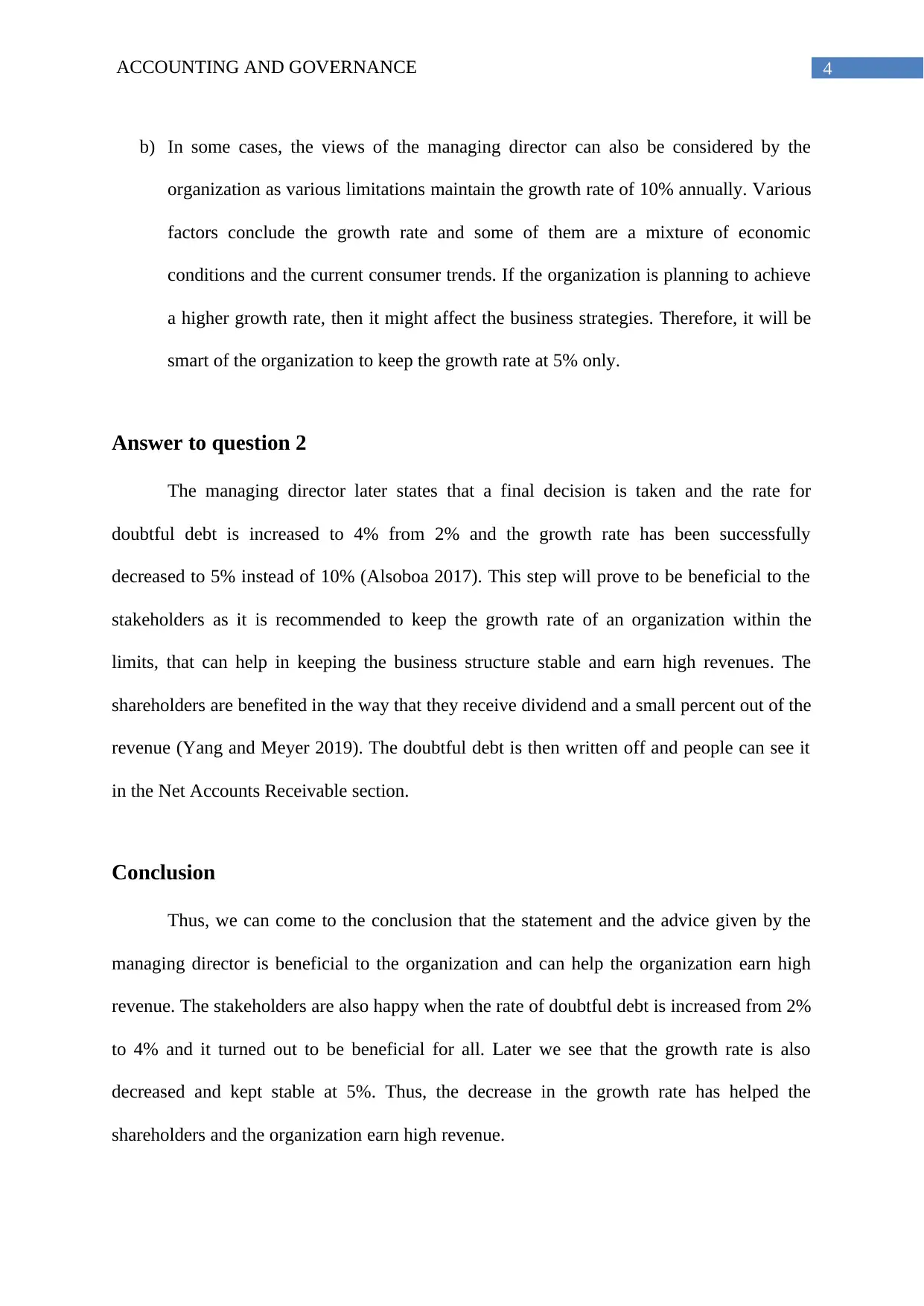
4ACCOUNTING AND GOVERNANCE
b) In some cases, the views of the managing director can also be considered by the
organization as various limitations maintain the growth rate of 10% annually. Various
factors conclude the growth rate and some of them are a mixture of economic
conditions and the current consumer trends. If the organization is planning to achieve
a higher growth rate, then it might affect the business strategies. Therefore, it will be
smart of the organization to keep the growth rate at 5% only.
Answer to question 2
The managing director later states that a final decision is taken and the rate for
doubtful debt is increased to 4% from 2% and the growth rate has been successfully
decreased to 5% instead of 10% (Alsoboa 2017). This step will prove to be beneficial to the
stakeholders as it is recommended to keep the growth rate of an organization within the
limits, that can help in keeping the business structure stable and earn high revenues. The
shareholders are benefited in the way that they receive dividend and a small percent out of the
revenue (Yang and Meyer 2019). The doubtful debt is then written off and people can see it
in the Net Accounts Receivable section.
Conclusion
Thus, we can come to the conclusion that the statement and the advice given by the
managing director is beneficial to the organization and can help the organization earn high
revenue. The stakeholders are also happy when the rate of doubtful debt is increased from 2%
to 4% and it turned out to be beneficial for all. Later we see that the growth rate is also
decreased and kept stable at 5%. Thus, the decrease in the growth rate has helped the
shareholders and the organization earn high revenue.
b) In some cases, the views of the managing director can also be considered by the
organization as various limitations maintain the growth rate of 10% annually. Various
factors conclude the growth rate and some of them are a mixture of economic
conditions and the current consumer trends. If the organization is planning to achieve
a higher growth rate, then it might affect the business strategies. Therefore, it will be
smart of the organization to keep the growth rate at 5% only.
Answer to question 2
The managing director later states that a final decision is taken and the rate for
doubtful debt is increased to 4% from 2% and the growth rate has been successfully
decreased to 5% instead of 10% (Alsoboa 2017). This step will prove to be beneficial to the
stakeholders as it is recommended to keep the growth rate of an organization within the
limits, that can help in keeping the business structure stable and earn high revenues. The
shareholders are benefited in the way that they receive dividend and a small percent out of the
revenue (Yang and Meyer 2019). The doubtful debt is then written off and people can see it
in the Net Accounts Receivable section.
Conclusion
Thus, we can come to the conclusion that the statement and the advice given by the
managing director is beneficial to the organization and can help the organization earn high
revenue. The stakeholders are also happy when the rate of doubtful debt is increased from 2%
to 4% and it turned out to be beneficial for all. Later we see that the growth rate is also
decreased and kept stable at 5%. Thus, the decrease in the growth rate has helped the
shareholders and the organization earn high revenue.
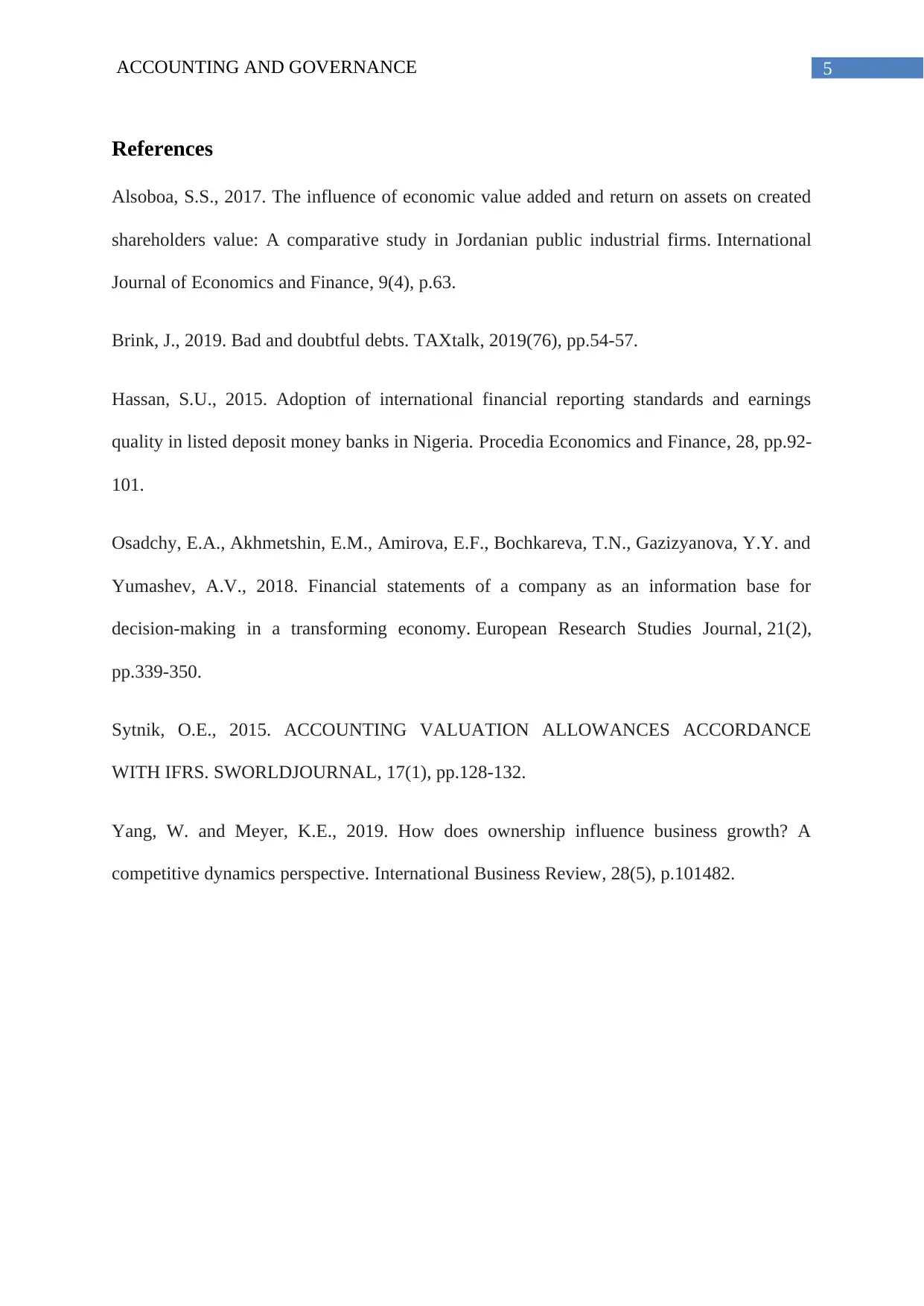
5ACCOUNTING AND GOVERNANCE
References
Alsoboa, S.S., 2017. The influence of economic value added and return on assets on created
shareholders value: A comparative study in Jordanian public industrial firms. International
Journal of Economics and Finance, 9(4), p.63.
Brink, J., 2019. Bad and doubtful debts. TAXtalk, 2019(76), pp.54-57.
Hassan, S.U., 2015. Adoption of international financial reporting standards and earnings
quality in listed deposit money banks in Nigeria. Procedia Economics and Finance, 28, pp.92-
101.
Osadchy, E.A., Akhmetshin, E.M., Amirova, E.F., Bochkareva, T.N., Gazizyanova, Y.Y. and
Yumashev, A.V., 2018. Financial statements of a company as an information base for
decision-making in a transforming economy. European Research Studies Journal, 21(2),
pp.339-350.
Sytnik, O.E., 2015. ACCOUNTING VALUATION ALLOWANCES ACCORDANCE
WITH IFRS. SWORLDJOURNAL, 17(1), pp.128-132.
Yang, W. and Meyer, K.E., 2019. How does ownership influence business growth? A
competitive dynamics perspective. International Business Review, 28(5), p.101482.
References
Alsoboa, S.S., 2017. The influence of economic value added and return on assets on created
shareholders value: A comparative study in Jordanian public industrial firms. International
Journal of Economics and Finance, 9(4), p.63.
Brink, J., 2019. Bad and doubtful debts. TAXtalk, 2019(76), pp.54-57.
Hassan, S.U., 2015. Adoption of international financial reporting standards and earnings
quality in listed deposit money banks in Nigeria. Procedia Economics and Finance, 28, pp.92-
101.
Osadchy, E.A., Akhmetshin, E.M., Amirova, E.F., Bochkareva, T.N., Gazizyanova, Y.Y. and
Yumashev, A.V., 2018. Financial statements of a company as an information base for
decision-making in a transforming economy. European Research Studies Journal, 21(2),
pp.339-350.
Sytnik, O.E., 2015. ACCOUNTING VALUATION ALLOWANCES ACCORDANCE
WITH IFRS. SWORLDJOURNAL, 17(1), pp.128-132.
Yang, W. and Meyer, K.E., 2019. How does ownership influence business growth? A
competitive dynamics perspective. International Business Review, 28(5), p.101482.
⊘ This is a preview!⊘
Do you want full access?
Subscribe today to unlock all pages.

Trusted by 1+ million students worldwide
1 out of 6
Related Documents
Your All-in-One AI-Powered Toolkit for Academic Success.
+13062052269
info@desklib.com
Available 24*7 on WhatsApp / Email
![[object Object]](/_next/static/media/star-bottom.7253800d.svg)
Unlock your academic potential
Copyright © 2020–2025 A2Z Services. All Rights Reserved. Developed and managed by ZUCOL.



